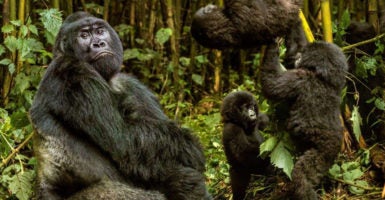When we touched down in Kigali, Rwanda, last Wednesday evening, oddly, there were no gorillas there to meet us at the airport. My travelling party and I felt somewhat let down by this, as we had been promised a greeting party of several large silverbacks. Alas, it looked as if we’d have to carry our own bags to the lodge in Bisate.
Jest aside, we were excited to get to see the wildlife and could not wait for the over 25-minute helicopter ride from Rwanda’s capital to the mountainous forest of Bisate to end.
Bisate is nestled amid a natural amphitheater of an eroded volcanic cone and has dramatic views of the peaks of the volcanoes Bisoke and Karisimbi, which peak above the Afro-alpine forests of nearby Volcanoes National Park.
The beauty and majesty of this land is without parallel, and we were all left speechless by the sheer vastness of the wilderness. It was all we had expected and then some.
Bisate is one of the most biodiverse regions in the world, home to thousands of species of mammals, birds, and reptiles of every description. But the star of the forest, as far as we were concerned, was the legendary and elusive mountain gorilla.
The Rwandan government carefully protects the species and its habitat while also making it accessible for tourism, the proceeds of which go toward local community development and conservation efforts.
Aside from tracking one of the several habituated gorilla groups, our scheduled activities included visiting nearby natural attractions and observing the park’s group of endangered endemic golden monkeys.
Although it is typical for Western tourists to go on “safaris” consisting of riding in an enclosed vehicle and observing large groups of animals during the rainy season, this excursion departed from the norm.
The lush forest is far too dense for a traditional safari. No, in order to capture our prize—a sighting of the famed beast—we would have to track it on foot through the dense underbrush. Luckily, we were in good hands. The local guides knew exactly what they were doing, and it was not long before we encountered our noble subject.
I have to say, we were taken aback by the sight of them up close, while the gorillas seemed bemused by our sense of wonder. They actually let us get quite near to them, gently observing us as we fumbled through the waist-high vegetation to their gathering.
You have no idea how big and powerful these animals are until you see them in their native habitat. Zoos do them no justice—and should in fact be outlawed. Keeping an animal of such majesty locked in a cage is a travesty of both God and nature.
On our layover flight from Baltimore to Athens, Greece, we stopped at the ancient ruins to pay homage to the origins of Western Civilization. They were indeed a reminder of the giants of the classical age, on whose shoulders our current civilization still rests. I could feel the presence of Aristotle and Homer there.
So, to go from Athens to Bisate in one day was quite a contrast. We went from the cradle of civilization to the cradle of humanity. They are two different things, you know.
Civilization is a refinement of culture. It is writ large and in bold relief. Humanity, on the other hand, is tiny in comparison to the natural surroundings in which it evolved.
The mere presence of the great apes, our close genetic cousins, proves it. Sitting in front of us is an animal that resembles us in so many ways.
Apes, like humans, are primates. Primates are unique among mammals in that they have large brains relative to their body mass. They also have an increased reliance on visual acuity at the expense of the sense of smell, which is the dominant sensory system in most mammals.
Notably, most primates also have opposable thumbs, otherwise known as the simian grip, which we also share as primates. These are the features of man, but they are not unique to human beings. We share these features with the great apes, which is perhaps why they fascinate us so intensely.
As I stood among a family group led by the king, a 16-year-old mature male, surrounded by his children and female mates, I could not help feeling a sense of majesty. They accepted us without complaint, calmly munching on vegetation and seemingly welcoming us as guests to their kingdom.
I grew up in nature on a farm in South Carolina—surrounded by both domesticated and wild animals—and so I have always felt a kinship with our fellow beings. But truly being surrounded by nature, walking in their sacred midst, was another experience altogether.
We are, as human beings, both Godly and beastly. I have often wondered which of our natures control us. Is it our sense of conscience and potential for the refinement of civilization? Or is it our animal instincts as displayed prominently by our genetic cousins the mountain gorilla? Are we merely a subspecies of ape, or are we another being entirely?
My Christian faith tells me that God made us in his own image and that we are uniquely endowed by the creator with a moral conscience. But my own eyes tell me, at this very moment, a completely different story. For in the gorilla’s gaze I detect an unmistakable sense of familiarity.
COPYRIGHT 2019 CREATORS.COM
































